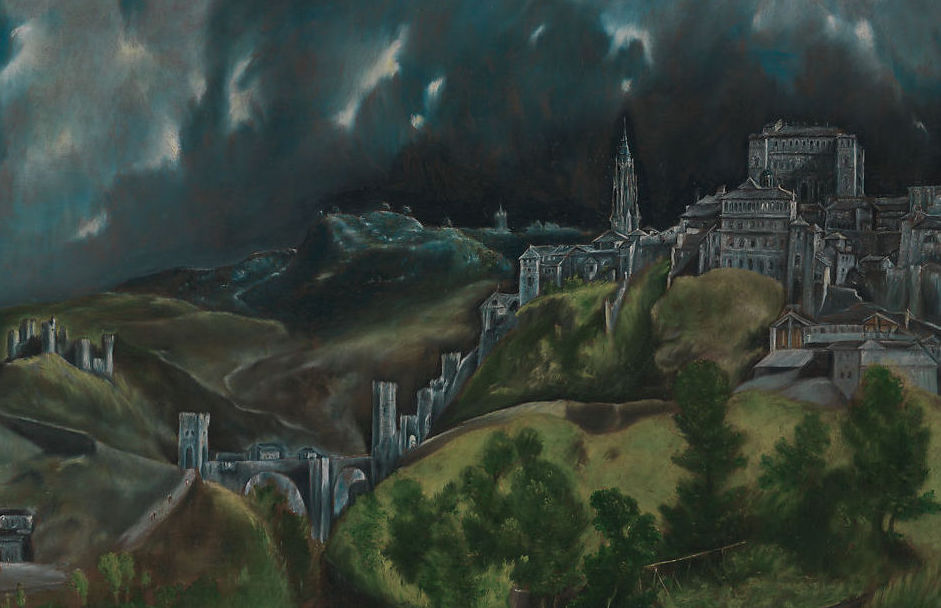“I have no hesitation in naming two works that are fundamental to me, gigantic: View of Toledo and The Vision of Saint John, both by the immense El Greco.
For an artist, art is never a choice among a thousand opportunities, but the only opportunity around which life is drawn. I fell in love with them after seeing them in a catalog, when I was about 18, and thanks to El Greco, I understood how fleeting the definition of contemporary art can be, a necessary classification to identify a product to be placed on the market.”
Among the greatest representatives of the Iberian Renaissance and the Spanish Golden Age, Domenikos Theotokopoulos(1541-1614), known as El Greco, painted View of Toledo in 1610, just a few years before his death. The painting, considered one of his most important and recognized works, exhibits the unmistakable style of the artist.
The representation is indeed dark and gloomy, with the landscape appearing ambiguous, accentuated by the spectral and threatening profile of the city rising from a bleak hilly landscape. The Castle of San Servando and the Alcázar Palace are faithfully reproduced, while other buildings were likely added by El Greco to balance the composition.
It is precisely in the color choice used to define the upper part of the canvas that El Greco’s style stands out. No one before him had “dared” to represent the sky with such tones and darkness, foreshadowing the traits of the avant-garde movements of the 20th century.
A few years before his death, El Greco also painted The Opening of the Fifth Seal, also known as The Vision of Saint John, which is also housed at the Metropolitan Museum of Art in New York. The painting played a crucial role in 20th-century painting.
It is said that Picasso, fascinated by the painting and a great admirer of the Cretan painter, found inspiration for the creation of Les Demoiselles d’Avignon. Originally conceived for a side altar in the church of San Juan Bautista outside the walls of Toledo, the canvas also included a top portion that was destroyed, where El Greco had represented sacred love in contrast with the lower part, depicting profane love.
Here too, we find the Mannerist taste for color, the dark representation of certain figures, and the expressive use of the sky and natural elements.
Bellobono continues: “It is superfluous to highlight how these two works are a concentrate of the history of painting from its origins to today. It is also clear how they are contextualized within the times we are living. View of Toledo, with its pale and gloomy colors, represents the sense of isolation and illness with which we are grappling, something also evident in The Vision of Saint John. When I finally managed to see them in person at the MET, it was an unforgettable moment of emotion.”
Biography
ANGELO BELLOBONO | Born in Nettuno in 1964, Bellobono lives and works between New York and Rome. He has participated in the XV Quadriennale of Rome, the IV and V Biennale of Marrakech, and the museum exhibition De Prospectiva Pingendi in Todi. His works have been shown in both public and private spaces such as the American University’s Katzen Art Center in Washington, AlbumArte, Spazio Mars in Milan, Fondazione Volume in Rome, the Museum of Modern Art in Cairo and New Delhi, Macro Museum in Rome, the Multicultural Art Center in Melbourne, Ciac Museum in Genazzano, Palazzo Re Enzo in Bologna, The Othersize Gallery in Milan, Wunderkammern Gallery in Rome, Changing Role Gallery in Naples, Envoy Gallery in New York, Frank Pages Gallery in Geneva, and Biasa ArtSpace in Bali.
He won the “Cultura e Arte” award from the Roma Foundation in 2019, the Celeste Prize for painting in 2005, and the Artslant Prize for drawing in 2009. He was a finalist for the Lissone Prize, the Combat Prize, and the Portali dello Scompiglio Prize. In 2010, he was invited to the Martedì Critici and in 2015 to Tedx-Roma. Over the years, he has been invited to various artist residencies including Bocs Cosenza, Landina Cars Omegna, and the Lac O Le Mon San Cesario Foundation in Lecce.
